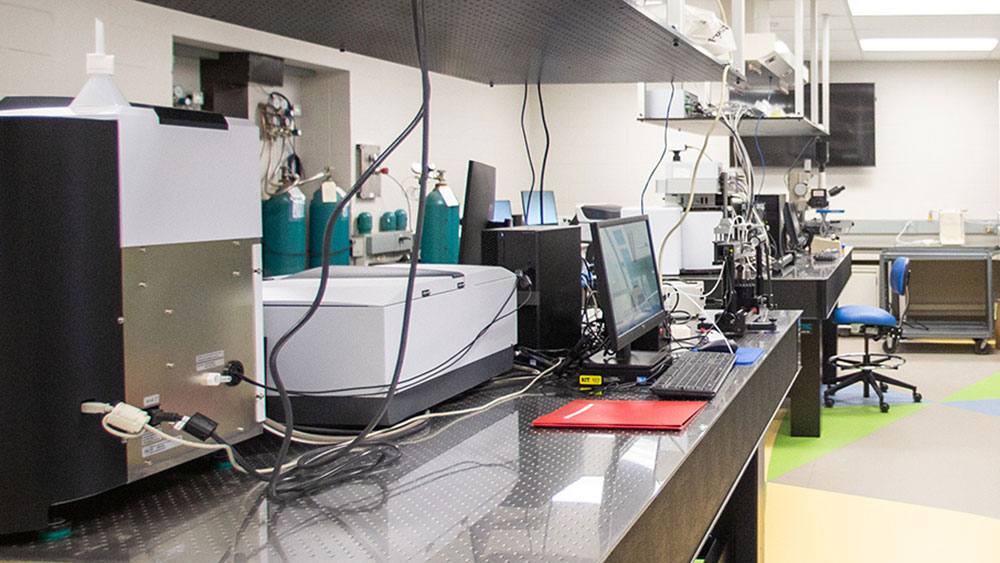Chemical Analysis Laboratory - Material Science Facilities

Chemical Analysis Laboratory
Material Science Facilities
- RIT/
- Chemical Analysis Laboratory
To sign up for instrument time, please use the Faces Scheduling System.
If you do not have an account then email Tom Allston, laboratory manager.
Atomic Force Microscopy
Atomic force microscopy (AFM) is a technique for analyzing the surface of a rigid material all the way down to the level of the atom . AFM uses a mechanical probe to magnify surface features up to 100,000,000 times, and it produces 3-D images of the surface.
- Operating Procedure
- Multimode AFM Training (Video)
- Bruker AFM Instructions (Video)
- Bruker Fluid Measurement (Video)
- Buker Nanoscope Analysis (Video)

Hybrid Rheometer
A rheometer is a device used to measure the rheological properties of materials; rheology being defined as the study of the flow and deformation of matter, which describes the interrelation between force, deformation and time.
- DHR QuickStart Guide (Video)
- Proper Sample Loading On The DHR (Video)
- DHR Geometries (Video)
- Linear Film Tension DMA Mode on the DHR (Video)

EDX/XRF
X-ray fluorescence (XRF) spectrometry is a non-destructive analytical technique used to obtain elemental information from different types of materials.

Xray Diffraction with thin film capability (XRD-RR)
X-ray diffraction utilizes scattering of X-rays by the atoms of a crystal that produces an interference effect so that the diffraction pattern gives information on the structure of the crystal or the identity of a crystalline substance

Scanning Electron Microscopy with EDX and Back Scatter
SEM provides detailed high resolution images of the sample by rastering a focused electron beam across the surface and detecting secondary or backscattered electron signal. An Energy Dispersive X-Ray Analyzer (EDX or EDA) is also used to provide elemental identification and quantitative compositional information.

- Tescan Vega 3 SEM (Video)
Raman Spectroscopy
Raman Spectroscopy is a spectroscopic technique typically used to determine vibrational modes of molecules, although rotational and other low-frequency modes of systems may also be observed.[1] Raman spectroscopy is commonly used in chemistry to provide a structural fingerprint by which molecules can be identified.

Differental Scanning Calorimeter (DSC)
Differential scanning calorimetry, or DSC is a thermoanalytical technique in which the difference in the amount of heat required to increase the temperature of a sample and reference is measured as a function of temperature.

Thermogravimetric Analysis (TGA)
Thermogravimetric analysis or thermal gravimetric analysis (TGA) is a method of thermal analysis in which the mass of a sample is measured over time as the temperature changes.

Differential Thermal Analysis and Thermogravimetry (DTG)
DTG is a technique that can measure both DSC and TGA of a sample at the same time.

Thermogravimetric Analysis (TGA)
Thermogravimetric analysis or thermal gravimetric analysis (TGA) is a method of thermal analysis in which the mass of a sample is measured over time as the temperature changes.

Fourier Transform Infrared Spectroscopy (FTIR)
Fourier Transform Infrared Spectroscopy (FTIR) is an analytical technique used to identify organic (and in some cases inorganic) materials. This technique measures the absorption of infrared radiation by the sample material versus wavelength. The infrared absorption bands identify molecular components and structures. An optical microscope is attached that allows one to examine small defects in materials (10 microns or less) and obtain an infrared spectrum of these small areas.





